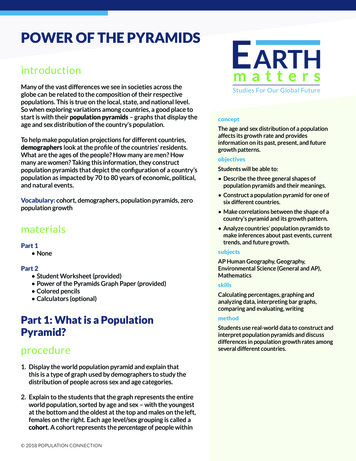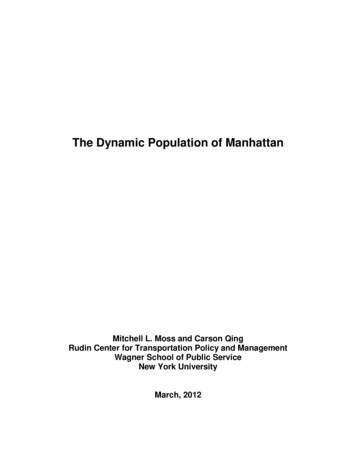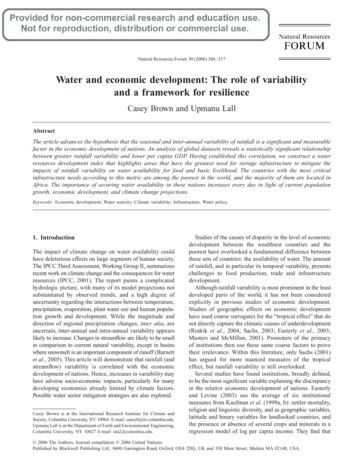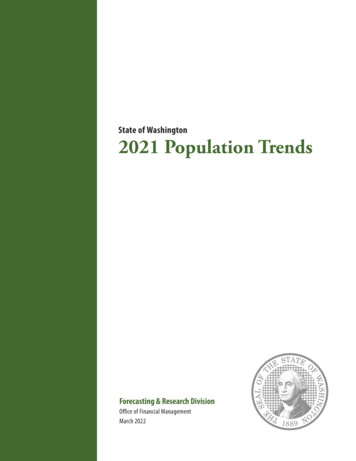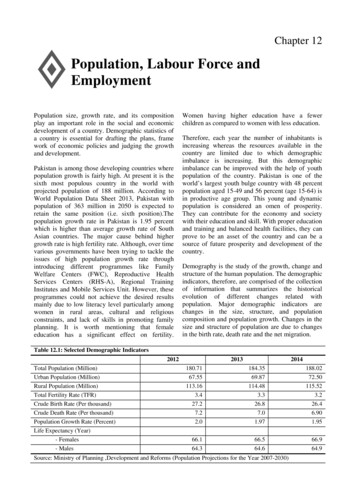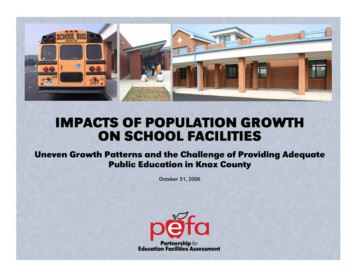
Transcription
IMPACTS OF POPULATION GROWTH ON SCHOOL FACILITIESUneven Growth Patterns and the Challenge of Providing Adequate Public Education in Knox CountyOctober 31, 2006EXECUTIVE SUMMARYA. IntroductionGrowth has occurred unevenly across KnoxCounty. West and north areas havecaptured large shares of new investment,while central, east, and south have seencomparatively little growth, even pockets ofdecline. Much of the growth has occurredon previously undeveloped land, creatingdemand for new roads, utility lines, schools,law enforcement, and fire protection. Thechallenge to provide adequate educationfacilities is sizeable, and accommodatingpopulation growth by building new schoolsis not always a viable option.B. Measures of School Facility CapacityFacility capacity is an important measure of aschool system’s ability to adequately serve itspopulation. Strains cause distraction anddisruption, a poor environment for learning.Fiscal burdens are another concern. Statemandates for teacher-pupil ratios cannecessitate the hiring of additional faculty, orswelling enrollments might dictate the additionof portable classrooms, building wings, or entirefacilities. Schools that operate well belowcapacity suffer problems of a different kind.Beyond the inefficiencies of operating aphysical plant that is not fully utilized, underpopulated schools often are unable to offercourses, programs, and extra-curricularactivities available at fully-utilized facilities.Considerable debate occurs over thedefinition of capacity and the subsequentevaluation of capacity-related problems.Several measures have been offered:1. Design Capacity: Measured bycounting the number of classrooms in aschool and multiplying by maximumallowable class size (based on mandated orrecommended standards for teacher-pupilratios). Limited by lack of attention paid toprogram-specific facilities.2. Square Footage Per Student: Ratio ofthe number of students to total building floorarea, compared to adopted standards: forexample, 150 square feet per elementarystudent, 170 square feet per middleschooler, and 180 square feet for highschool students. Mechanistic standard,detached from important programmaticconsiderations.3. Basic Education Program Capacity:Maximum number of students a facility canaccommodate after applying grade level orgroup averages (K-8) and programmaticofferings to teaching stations (9-12) within afacility. Does not allow for instructionalneeds of special or unique student groups.4. Functional Capacity: Accommodates aschool’s programmatic issues andmeasures its ability to adequately serve itsstudents. Current usage of educationalprogram space and the pre-determinednumber of students assigned to each spacecomprise the basic formula for functionalcapacity. Excludes floor area dedicated toImpacts of Population Growth on School Facilities1special uses during school day, such asspecial education resource rooms, readingcenters, computer laboratories, andperforming arts centers.C. Capacity ThresholdsExperts contend that facility strains beginwhen enrollment approaches 80 to 85percent of designated limits becausescheduling requirements make it impossibleto assign students to all teaching stationsevery period of every day. Utilization factorsthat mark a standard threshold of capacityhave been adopted by many schoolsystems across the country.Capacity measures and comparisons withcurrent and future enrollments arepresented for Knox County’s high, middle,and elementary schools:1. High Schoolsa. Current conditions: Among KnoxCounty’s 12 high schools, eight exceed oneor more of the thresholds of capacity basedon current enrollments in the system.Bearden, Farragut, and Karns, top each ofthe floor area, BEP, and functional capacitylimits. These schools serve the high growthsouthwest and northwest portions of KnoxCounty. On the other hand, enrollments atAustin East, Carter, Fulton, and SouthDoyle, which cover slow growth areas ofcentral city, east county, and south county,remain below capacity in all threemeasures.
KCS officials look primarily at functionalcapacity in their evaluation of schoolovercrowding, and average dailymembership at six facilities (Bearden,Central, Farragut, Karns, Powell, and West)exceeds the 85 percent threshold. Five ofthose schools serve northwest andsouthwest Knox, demonstrating thepressures that population expansion haveplaced on the local infrastructure. Threehigh schools, Bearden, Central, and Karnsreport more than 95 percent of functionalcapacity usage.b. Future conditions: Systemwide,current high school enrollment exceeds itsfunctional capacity threshold, combining for87.3 percent of total available space. In2005, the Knox County School Board andKnox County Commission approved plansfor construction of a high school in thenorthwest part of the county. The new257,581-square foot Hardin Valley HighSchool will accommodate 2,100 studentsand ease overcrowding at Farragut, Karns,and Bearden. The school is scheduled toopen in phases, beginning in Fall semester2008, and it will be completely operational inFall 2010. Also, an addition is nearingcompletion at Karns High School. The23,450-square foot project should be readyin January, 2007.Based on enrollment projections for Fallsemester 2011/12, there will be 15,682students in Knox County’s public highschools. That represents a small decline inenrollment when compared to currentfigures, the result of changing localdemographic conditions. In recent years,birth rates dropped as women of childbearing age (15 to 45 years old) werehaving fewer children. Smaller numbers ofkindergarten children entered the schoolsystem in the late-1990s and early-2000s,and as that cohort ages and progressesthrough grade levels, an enrollment troughwill be seen in the system for a few years. Itis assumed that local migration trends willcontinue at current levels, such that morefamilies will move into Knox County than willmove away, however, those arriving willbring fewer children.Current construction projects will relievegrowth pressures on area high schools overthe next five years. More than 280,000square feet of space will be added with theexpansion at Karns High School and theconstruction of Hardin Valley High School.The added footage will bring the total highschool space inventory to 2.94 millionsquare feet. Projected enrollments call for15,682 students in 2011/12, which equatesto 188 square feet per student, above thestandard of 180 square feet. Total highschool system BEP capacity will rise from20,766 to 23,286, meaning the proportion ofBEP capacity in use will be 67.3 percent,comfortably below the 85 percent threshold.Similarly, the systemwide functionalcapacity will grow from 18,689 to 21,209,resulting in a 73.9 percent portion in use.With the additional capacity afforded byHardin Valley High School, overcrowdingproblems at Bearden, Farragut, and Karnswill be eliminated.2. Middle Schoolsa. Current conditions: Knox County’s 14middle schools currently operate with 1.87million square feet of space, serving nearly12,000 students. With a total BEP capacityof 14,322, the system runs at 83.4 percentcapacity. Similar numbers are seen forImpacts of Population Growth on School Facilities2functional capacity. As a result, the middleschool system as a whole has room to grow.However, that assessment is the net resultof uneven distribution of middle schoolpopulation. A few facilities are operatingwell below current capacities, such asSouth-Doyle, while others exceed functionalcapacity limits. Farragut, Gresham, Halls,Holston, and Powell are more than 90percent occupied, and Karns Middle hasreached the 85 percent threshold. Sixfacilities exceed BEP standards. Tenschools do not meet floor area standards,but only one, Powell Middle, is sharplybelow the minimum.b. Future conditions: Major buildingadditions are currently underway at Holstonand Powell Middle Schools. Holston willadd 61,000 square feet and will be able toaccommodate 1,200 students. Preliminaryestimates for the Powell addition show100,000 square feet of new space, with anapproximate capacity of 1,200 students. Asa result, systemwide Fall enrollments in2011/12 will be accommodated as BEP andfunctional capacity numbers will drop toabout 81 percent in use, with Holstonexpected to report less than 70 percentoccupancy and 64 percent at Powell. Whilethese additions will relieve some strain forthe system as a whole, capacity pressureswill remain at Farragut, Gresham, Halls, andKarns. If attendance zones are adjusted inconjunction with the construction program,these additional capacity issues might bealleviated.3. Elementary schoolsa. Current conditions: The systemwideinventory of 50 elementary schools currentlyoperates at 87.3 percent of total BEP
capacity, with 33 schools at or above the 85percent threshold. Enrollments occupy 86.1percent of total functional capacity, with 22schools over the 85 percent mark. Fifteenfacilities are more than 90 percent full, fiveof which are over 100 percent occupied. Ifthe 85 percent threshold is to bemaintained, the elementary school systemmust find additional room for 664 studentsunder BEP guidelines, and 329 studentsunder functional capacity definitions.b. Future conditions: There are effortsunderway to add space to the elementarysystem. A 125,000-square foot Cedar BluffElementary School is under constructionand will replace the 105,520 square feetcurrently held in the primary andintermediate buildings. Capacity of the newschool, however, will be smaller than thecombined total of the two existing facilities.No plans have been announced for use ofthe existing buildings once the new school isopen. Also under construction is a newGibbs Elementary School, a 124,000-squarefoot building that will replace the 39,000square foot structure that currently servesthe area. With this replacement, there willbe a net gain of 300 in functional capacity,for a total of 1,000 seats at Gibbs.Even with the current construction projects,there will be elementary school capacityshortages by 2011/12. Systemwide BEPcapacity will be 28,472, but 25,513 studentsare projected, resulting in a 1,312-seatshortfall if an 85 percent threshold ispreferred. Functional capacity is expectedto total 28,827, which will represent ashortage of 1,010 spaces.D. Growth ManagementKnox County is not alone in its struggle tobalance the demands of growth and theprovision of adequate public educationfacilities and services. Planners across thecountry have been developing growthmanagement tools, innovative mechanismsthat take two general forms: a) seek newfunding sources beyond traditional meanslike sales or property taxes, which cannotkeep pace with service and infrastructuredemands; and, b) control the pace ofgrowth so communities can add services ata rate that does not strain limited naturaland economic resources.Growth management principles aredesigned to achieve several major goals,two of which are particularly pertinent to thisreport:1. Location and Character of CommunityExpansion: Managed by a community’szoning ordinance, subdivision regulations,and comprehensive plan, which specifywhere, when, how much, and what kind ofdevelopment can occur. Supplementingthese traditional measures, communitiescan manage growth using any number ofadditional techniques, such as urban growthboundaries, development policy areas, infilland redevelopment areas, and growth limits.2. Provision of Infrastructure: Controlledtiming of new service and infrastructuredelivery, especially when trying to meet tightfunding requirements. Functional plans,adequate public facility requirements,exactions, fees, special districts, and projectrating systems are growth controls used inmany places. Several of the regulatory andfiscal management tools noted above haveImpacts of Population Growth on School Facilities3been authorized and adopted incommunities across Tennessee.E. Comparison of Knox County toPlaces with Formal DevelopmentControlsAs a result of rapid and unevenly distributedpopulation growth in Knox County in recentyears, many public schools have reached orexceeded facility capacity. School boardoptions, such as rezoning, portableclassrooms, reuse of space, and facilityconstruction, can relieve some of thepressure. However, does local schoolinfrastructure deficiency call for the kinds oflegislated growth controls used in otherplaces in Tennessee and elsewhere in thecountry? Knox County growth wascompared to growth in 34 communities inFlorida, Maine, Maryland, New Hampshire,North Carolina, and Tennessee wheremanagement devices, such as impact fees,adequate facilities taxes, and concurrencyrequirements, have been implemented.1. General Population: Between 1980and 2000, total population growth in KnoxCounty reached 62,000 (a nearly 20 percentincrease), much of which occurred in the1990s when a 14 percent increase wasrecorded. In comparison to the 34 growthcontrol communities, Knox County’s netincrease earned a ranking of 20th. Its rate ofchange, however, sent it down the list to30th place. When compared to the 14selected Tennessee counties with growthmanagement policies, Knox led all but threein net growth.2. Population Under 20 Years of Age:Persons aged 0 to 19 years represent theschool age population cohort of acommunity. In Knox County, the 20-yeargrowth trend showed a 3,400 person
increase, a 3.6 percent change, the netresult of 12 percent growth in the 1990s anddecline in the decade prior. In comparisonto the growth control communities, Knoxwas at the bottom of the list, ranking 33rd outof 34.3. Public School Enrollment: KnoxCounty public schools added about 7,500students during the 1990s. In terms of rateof change, a sizeable decline in the 1980soffset the increase in the 1990s, resulting ina 20-year net of 5.3 percent decline.Accordingly, Knox County was at the bottomof the ranks for total and percentage changewhen compared to the selected growthcontrol communities. However, if the growthof the 1990s is considered separately, KnoxCounty’s increase earned a 5th placeranking in Tennessee.4. Mixed Findings: Local population andenrollment trends show mixed results.When compared to communities with growthmeasures in place, Knox County fallstoward the bottom of rankings for populationchange, indicating that pressures locally arenot as intense as those felt elsewhere.However, development in Knox has notbeen distributed evenly. Southwest,northwest, and north areas have seen ratesof increase that rival those in many of thecommunities that have taken formal actionto control the timing and direction ofinvestment.F. Options to Tackle SchoolOvercrowding1. Operational Choices: Several localschools, in older parts of the city and otherareas that have seen little new residentialinvestment, have excess capacity. Realignment of school attendance zones couldtake children out of overcrowded schoolsand redistribute them to zones withavailable space. However, children musttravel greater distances to school, requiringadditional bus service; re-assignment ofchildren from one school to another incurssizeable administrative expense; and,rezoning causes public consternation.Facility operation strategies, such as theaddition of staff and portable classroomsand reconfiguration of space, have relievedgrowth pressures at some local schools. Inareas of strongest growing pains though,facility expansion and new schoolconstruction were undertaken, but the fiscalcosts were substantial.committees. Local planners andgovernment officials could participate in theschool board’s long-range planning andfacility location activities.c. Joint use agreements: Recognize therole of school facilities as community assetsserving multiple functions: meeting places,parks, recreation centers, libraries, andother shared uses.d. Impact analysis in review ofdevelopment proposals: Collaborate withschool officials on proposalrecommendations and routinely sharedevelopment data (anticipated number ofbuilding units, additional population, schoolenrollments, facility capacities, enrollmentprojections, development projections).e. School facilities element in thecomprehensive plan.2. Long-Term Opportunities for a BetterPlanning Environment: A Toolkit ofOptionsf. Requirement of school site dedication:Land set aside by developers of large-scaleresidential projects.a. Cooperative efforts: Zoning andsubdivision review processes could benefitfrom more rigorous guidelines and greatercooperation between planners, educators,and elected officials. The environment forcollaborative planning is improving though.For the past three years, MPC staffmembers have worked closely with KCSand formalized a planning assistanceprogram.g. Financing options like school impactfees.b. Interlocal agreement: School boardstaff members could participate in local landuse decisions and serve on technicalImpacts of Population Growth on School Facilities4The Metropolitan Planning Commissioncurrently accommodates several of theaction items listed above, and additionalmeasures could be considered. Plannersand educators must work with electedofficials on school facility siting and capacitymatters and foster an environment ofunderstanding about the roles developmentactivity, land use and facility planning, andcapital improvement programming have oncurrent and future school needs.
IMPACTS OF POPULATION GROWTH ON SCHOOL FACILITIESUneven Growth Patterns and the Challenge of Providing Adequate Public Education in Knox CountyOctober 31, 2006I. INTRODUCTIONKnox County’s population has been growingsteadily over the past 15 years. West andnorth areas have captured large shares ofnew investment, while central, east, andsouth Knox have seen comparatively littleexpansion, even pockets of decline.Exacerbating the issue is the fact that muchof the growth has occurred on previouslyundeveloped land. As a result, new roads,utility lines, schools, law enforcement, andfire protection are needed, a challenge thatconfronts local taxpayers increasingly eachyear. The focus of this report is the impactof growth on Knox County’s public schoolsystem.The provision of adequate educationfacilities is a sizeable fiscal responsibility,and accommodating population growth bybuilding schools is not always a viableoption. Careful attention must be paid to theeffects of growth before it occurs.Accordingly, growth and its impacts onschool infrastructure are assessed in thisreport. An overview of local publiceducation facilities is presented, including alook at changing enrollments and facilitylimitations. Considerable attention is paid tothe concept of school capacity, with severaldefinitions discussed. Finally, becausepressures on public education services arenot unique to Knox County, planning optionsused in other communities around thecountry are examined for applicability here.II. KNOX COUNTY’S PUBLICSCHOOL FACILITY CAPACITIESA. Uneven Distribution of GrowthKnox County witnessed population increaseover the past 15 years. While growth wassteady, averaging 1.4 percent annually, thegains were distributed unevenly across thecounty. Analysis of sector-level populationchange and construction activity revealed adistinct pattern of expansion that stronglyfavored southwest, northwest, and northportions of the county, while other areas,especially sectors in the city, saw little newgrowth, even decline. Patterns of school-agepopulation distribution mirrored the generalpopulation, and half of all public school studentsresided in the three growth-centered sectorswest and north of the city. (Detailed figures onpopulation, development activity, and schoolenrollment trends are presented in Appendix A.)Much of the residential investment thatoccurred over the past 15 years took placeon previously undeveloped land. As aresult, public infrastructure had to grow withthe new population. The time and moneydemands to provide infrastructure havebeen substantial, and Knox County hasbeen challenged to keep pace. Schools inparticular have felt the pressure, as manyeducation facilities in areas of rapid growthhave difficulty accommodating enrollmentincreases. New school construction hastaken place in the past few years insouthwest and northwest Knox County, withfacilities such as A.L. Lotts Elementary,Impacts of Population Growth on School Facilities5Hardin Valley Elementary, AmherstElementary, West Valley Middle School, andHardin Valley High School (currently underconstruction), added to the local inventory.A new facility to replace Cedar Bluff Primaryand Elementary Schools is being built, andenrollment estimates for the school indicateit will open at or near capacity. Expansionsand portable classrooms also have occurredat many west and north schools to handlegrowth. Current trends in population growthand land development indicate continuedpressure in southwest, northwest, and northKnox County over the next several years.At the same time that burgeoningenrollments have pushed many facilities tocapacity and beyond, several other areaschools have been operating belowcapacity. Shifting population and unevendistribution of growth have contributed toenrollment declines in many of Knoxville’solder, established neighborhoods.B. Measures of School Facility CapacityFacility capacity is an important measure ofa school system’s ability to adequatelyserve its population. Strains on capacitycause problems with the day to dayeducation of students – for example, classsizes that exceed accepted teacher-pupilratios restrict attention to individual studentneeds; or, auditoriums, gymnasiums,libraries, and storage rooms might be calledupon to serve as classroom space. Fiscalburdens are another concern. Statemandates for teacher-pupil ratios might
necessitate the hiring of additional faculty,or swelling enrollments might dictate theaddition of portable classrooms, buildingwings, or entire facilities. Excessivepressures on facilities and human resourcestranslate to conditions of distraction anddisruption, a poor environment for learning.Schools that operate well below capacitysuffer problems of a different kind. Beyondthe inefficiencies of operating a physicalplant that is not fully utilized, underpopulated schools often are unable to offercourses, programs, and extra-curricularactivities available at fully-utilized facilities.Facility capacity is difficult to assess becausethere exists considerable debate over itsdefinition and subsequent evaluation ofcapacity-related problems. Several measureshave been offered, each with generallyaccepted norms for assessment. The debate,however, lies in the selection of an appropriatedefinition of capacity, often based on which sideof the issue one stands when considering theimpacts of overcrowded or underutilizedschools. The more widely adopted measuresof school capacity are presented here:1. Design CapacityDesign capacity is measured by countingthe number of classrooms in a school andmultiplying by maximum-allowable classsize (based on mandated or recommendedstandards for teacher-pupil ratios). It is astraightforward and commonly used gaugefor schools with self-contained classroomsof similar size, however, it is limited by itslack of proper attention paid to programspecific facilities (DeJong and Craig, 1999).Specialized spaces, such as science labs,art rooms, media centers, and music rooms,are not used every period of every day and,therefore, when included in the measure ofdesign capacity, total accommodations areoverstated. Further, it would not beacceptable to include temporary or portableclassrooms in the calculation of designcapacity. Only footage in permanentstructures should be included – temporaryspace creates temporary capacity which canmask real facility needs (Chan, 1998).2. Square Footage Per StudentAnother measure of the carrying capacity of aschool, one often used by architects indesigning new facilities, is the ratio of thenumber of students to total building floor area.That ratio is then compared to generallyaccepted standards for elementary, middle,and high school facilities. The District ofColumbia, for example, uses a standard of 150square feet per elementary student, 170square feet per middle schooler, and 180square feet for high school students(Neighborhood Capital Budget Group, 2005a).Like design capacity, this is an example of amechanistic standard, detached from importantprogrammatic considerations.3. Basic Education Program CapacityThe Knox County Schools system is agrade-based structure with K-5, 6-8, and 912 elements. The K-5 component provides aself-contained instructional strategy wherestudents are primarily assigned a singleteacher. Enrichment activities, such as art,music, and physical education, are includedin their program in small increments eachweek. Teaching stations for these activitiesare typically unused for a significant timeeach day. However, the nature of theassociated learning content often requiresequipment and spaces not conducive to atraditional classroom. Under State ofTennessee’s Basic Education Program(BEP) guidelines, grades K-3 must adhereImpacts of Population Growth on School Facilities6to a pupil-teacher ratio (PTR) not exceedingan average of 20.49. Grades 4 and 5 allowa PTR of 25.49.The middle grades are structured aroundsmall learning communities, with a team ofteachers assigned to areas of professionalexpertise. The BEP mandate for PTR is25.49 for grade 6 and 30.49 for grades 7and 8. Students rotate among their team ofteachers for academic core subjects. Coreteachers provide instruction within theirteams for about 75 percent of the schoolday. Students participate in arts programsfor the remaining time each day, throughoutthe school year. Core teaching stations arevacant during these times. Related artsopportunities exceed offerings at the K-5level and include computer skills, band,choir, and technology education. Aschedule is created at each middle school toaccommodate the total school population.The majority of teaching stations dedicatedto related arts programming provideinstruction for more than 85 percent of anygiven school day. Most arts stations are notsuited for academic core instruction.High schools (grades 9-12) have a muchdifferent structure. Approximately one-halfof each student’s coursework is requiredand scheduled for them. Students areallowed to choose an individual path ofcoursework for the remaining half. Thesecourses can be completed with multiplegrade-level students in the same class.Academic, arts, career/technical education,and other elective offerings are treatedequally in the master schedule. All teachingstations throughout the facility affectprogram capacity. BEP ratio requirementsfor high schools vary by instructional area(Table 1).
TABLE 1TENNESSEE BASIC EDUCATION PROGRAM(BEP) REQUIREMENTS FOR HIGH SCHOOLSINSTRUCTIONAL AREAArtBandCareer and Technical EducationChoral MusicDrivers EducationForeign LanguageGeneral MusicLanguage ArtsMathPhysical Education, Health, WellnessPhysical SciencesROTCSocial SciencesTABLE 2TENNESSEE BASIC EDUCATION PROGRAM (BEP) CAPACITYSTANDARDS FOR KNOX COUNTY HIGH SCHOOLSPUPIL-TEACHERRATIOHIGH SCHOOL30No Limit20No Limit203030303030302030Austin rnsPowellSouth DoyleWestTotalSource: Knox County Schools, 2005.TOTAL DAILYMAXIMUM CAPACITYADJUSTED DAILYCAPACITY (1 OF 1,4091,3751,5602,1121,4371,8601,78220,7661Capacity after BEP adjustments and allocation to one of four scheduling blocks.Source: Knox County Schools, 2005.To summarize, the Basic EducationProgram capacity is the maximum numberof students a facility can accommodate afterapplying grade level or group averages (K8) and programmatic offerings to teachingstations (9-12) within a facility (Grubb,2005). (To illustrate, BEP capacity figuresfor Knox County’s 12 high schools areshown in Table 2.) According to educators,including Knox County Schools (KCS) staff,BEP capacity measures fall short inadequately assessing the capabilities of afacility to provide a proper learningenvironment. From KCS research, suchmeasures do not allow for instructionalneeds of special or unique student groups,and they fail to consider the fact thatstudents do not fit into predeterminedgroups consistent with BEP mandates.4. Functional CapacityIn response to the shortcomings of the threecapacity measures outlined above, a fourthmethod has been advocated locally andelsewhere across the country. Functionalcapacity accommodates a school’sprogrammatic issues and measures itsability to adequately serve its students –current usage of educational program spaceand the pre-determined number of studentsassigned to each space comprise the basicformula for functional capacity. Often calleda more realistic measure by schooladministrators, functional capacity is lowerthan design capacity because it excludesfloor area dedicated to special uses during aschool day, such as special educationresource rooms, reading centers, computerImpacts of Population Growth on School Facilities7laboratories, and performing arts centers(Planning Advocates, 2003).Knox County Schools staff have definedfunctional capacity as the number ofstudents a school can accommodate whilesimultaneously: a) creating a safe andgrade-level appropriate learningenvironment, b) prioritizing curriculumdelivery and instructional opportunities tomeet student need, c) adhering to pupilteacher ratio mandates, d) allowingstudent/family program choices whenapplicable, e) maximizing teaching stationutilization, f) applying variables for sitebased program factors, g) adjusting capacitysocio-economic status, and, h) applying theKnox County Schools “best-practicecapacity benchmark.”
KCS generated a set of figures for functionalcapacity for area elementary, middle, andhigh schools using a locally developedfacility model. Staff members examinedutilization of each of their instructionalfacilities in depth over the past eighteenmon
High Schools a. Current conditions: Among Knox County's 12 high schools, eight exceed one or more of the thresholds of capacity based on current enrollments in the system. Bearden, Farragut, and Karns, top each of the floor area, BEP, and functional capacity limits. These schools serve the high growth southwest and northwest portions of Knox .


